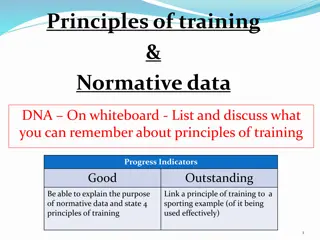Fitness Data Collection Methods: Benefits and Limitations
Utilizing standardised fitness tests and Time Related Observation Schedule (TROS) can offer valuable insights into an individual's fitness levels and performance during various activities. While these methods provide detailed information and aid in monitoring progress, they also come with limitations such as inconsistencies in results due to external factors and the performer's motivation. Understanding these benefits and limitations is crucial for effective data collection in physical education and sports science.
Download Presentation

Please find below an Image/Link to download the presentation.
The content on the website is provided AS IS for your information and personal use only. It may not be sold, licensed, or shared on other websites without obtaining consent from the author.If you encounter any issues during the download, it is possible that the publisher has removed the file from their server.
You are allowed to download the files provided on this website for personal or commercial use, subject to the condition that they are used lawfully. All files are the property of their respective owners.
The content on the website is provided AS IS for your information and personal use only. It may not be sold, licensed, or shared on other websites without obtaining consent from the author.
E N D
Presentation Transcript
Higher PE Data Collection Benefits & Limitations
Standardised Fitness Test: Cooper Test Performer Performance Level Age Sex Excellent Good Fair Poor 13 14 years Male 2700 2400 2200 2100 Female 2000 1900 1600 1500 15 16 years Male 2800 2500 2300 2200 Female 2100 1900 1700 1600 17 18 years Male 3000 2700 2500 2300 Female 2300 2100 1800 1600
Benefits The use of Standardised Fitness Tests can give you clear information about the relevant components of fitness that you are trying to measure and therefore acts as a fitness indicator (identifies strengths and weaknesses in fitness). Also, the use of norms allow you to compare your score with those of the same age and gender around the world (valid and reliable results due to test conditions being standardised). It is important that any fitness assessments that you carry out are relevant to the nature of the activity that you are interested in improving (i.e. select areas of fitness that apply to football CRE, which are all required at some point in the game). This method of testing can also be used for monitoring progress during a fitness training programme, gauging when adaptations to training are necessary and to evaluate any improvements at the end of the plan of action.
Limitations Results can be subject to inconsistencies in timing and recording, which can impact on the validity and reliability of results. Performance on these tests can be affected greatly by a performer s motivation. If a performer doesn't give maximum effort during the test their score will not be a true reflection of their fitness levels. As the test can be conducted outside, the environmental conditions can affect the validity and reliability of the results. Also, the athlete s choice of footwear and the surface they are running on can effect times greatly, which can impact on the validity and reliability of results. Pacing and practice can influence the scores attained.
TROS: Time Related Observation Schedule 0-5 mins 5-10 mins 10-15 mins 15-20 mins Standing Still Walking Jogging Sprinting Turns/changes direction to lose marker. On or Off ball Moves quickly to intercept a pass Moves to support player on the ball Tracks back to defend
Benefits Easy to complete and not time consuming. Can be filled in through peer or self-analysis. Tick Trends stand out so strengths and weaknesses can be identified at a glance which provides the information you need to collect more focussed data on your performance. The time zones allow you to pin point exact phases of the game where performance levels are high or low. Sport Specific information is gathered which allows you to identify strengths and weaknesses relevant to your own performance.
Limitations If teams are uneven and the recorded game becomes one-sided then results could be invalid, as strengths and weaknesses identified may not reflect a performer s true ability. If the teams used to collect initial data, are altered for the midway and/or post training programme data collection, then comparison of results will be unreliable as test protocol has been broken. As this sheet is completed through self-analysis, it requires the performer to complete ticks and crosses with complete honesty. If the performer completes their sheet with any hint of bias, then the results will also be invalid.
Sports Emotions Questionnaire Scoring Instructions: Not at all 0 0 0 0 0 0 0 0 0 0 0 0 0 0 0 0 0 0 0 0 0 0 A little 1 1 1 1 1 1 1 1 1 1 1 1 1 1 1 1 1 1 1 1 1 1 Moderately 2 2 2 2 2 2 2 2 2 2 2 2 2 2 2 2 2 2 2 2 2 2 Quite a bit 3 3 3 3 3 3 3 3 3 3 3 3 3 3 3 3 3 3 3 3 3 3 Extremely 4 4 4 4 4 4 4 4 4 4 4 4 4 4 4 4 4 4 4 4 4 4 Uneasy Upset Exhilarated Irritated Pleased Tense Sad Excited Furious Joyful Nervous Unhappy Enthusiastic Annoyed Cheerful Apprehensive Disappointed Angry Energetic Happy Anxious Dejected Fear = (uneasy + tense + nervous + apprehensive + anxious)/5 = ________ Dejection = (upset + sad + unhappy + disappointed + dejected)/5 = _________ Excitement = (exhilarated + excited + enthusiastic + energetic)/4 = _________ Anger = (irritated + furious + annoyed + angry/4 = _________ Happiness = (pleased + joyful + cheerful + happy)/4 = ________
Benefits The written format provides a permanent record that allows for comparison at a later date. Strengths and weaknesses can be identified from the questionnaire which future performance development programmes and goal setting can be based upon. The performer is gaining lots of information on their emotional state. The more information they have on their performance the more accurate and valid the results. A coach/teacher/performer can get large quantities of information about Emotional factors in a relatively short period of time. Subsequently, strengths and more importantly weaknesses can be identified quickly and addressed through an appropriate development programme and monitoring process. Everyone in the class is answering the same questions. This reduces bias and increases the validity and reliability of the results because the performers are not being influenced by an interviewer.
Limitations The information which is being collected is based on a performer s perception of their emotional state. Subsequently, this could impact on the validity of the results as it could be a bias assessment. It depends on the importance a performer places on the process. If a performer doesn't take the process seriously this will impact of the validity and accuracy of the results. Results could be inaccurate if a performer misinterprets the words. It can take a long period of time to collect and analyse the results. The questions being asked are only closed questions. A lack of open questioning means that the performer s answers lack explanation, which could impact on the accuracy of the results.
Discipline Record First quarter Second quarter Third quarter Forth quarter Negative body language to personal mistake Negative body language to team mistake Negative verbal reaction to personal mistake Arguing with team Arguing with the other team Contesting referee s decision Decrease in effort Foul Cynical Foul Act of sportsmanship Off the ball incident Use of positive praise
Benefits The written format provides a permanent record that allows for comparison at a later date. Having an observer it provides objective feedback which is non-bias providing more accurate results. All tally marks can be converted into statistics which are hard to argue with. Strengths and weaknesses relating to emotions can be identified from the record which future performance development programmes and goal setting can be based upon. Objective feedback by a person with activity knowledge ensures validity and reliability of the results to create a detailed analysis of emotional state. By playing a full game of football against opponents of equal ability allows the observer plenty of time to collect valid, reliable and accurate information. The duration of the game gives the observer time to observe patterns of behaviour.
Limitations When you have someone else recording information on performance the validity of the results are dependent on the observers focus and attention during the match and the importance they place on the process. Football is a very fast paced sport and there is likely to be a number of incidents and patterns of play. If an observer takes their eye of the match to complete the record they may miss something which brings into question the reliability of the findings. The content of the disciplinary record has to be correct in the first place to focus on key elements of emotional performance. The information which is being collected is based on an observer s perception of what represents a negative behaviour or action. Subsequently, this could impact on the validity of the results as it could be a bias assessment.























